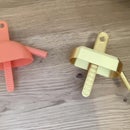Introduction: Speaker Resonating Device
The DIY speaker device I'd like to introduce is a unique creation that harnesses the power of water to create mesmerizing patterns. This innovative device combines the principles of sound and fluid dynamics to produce a captivating audio-visual experience. By connecting an audio source to the device, sound vibrations are transmitted through a specialized membrane, causing water droplets to dance and ripple in response to the music. The patterns formed by the water create a stunning visual display that adds an extra dimension to the listening experience. With its DIY nature, this speaker device allows enthusiasts to explore their creativity by customizing the design and experimenting with different water patterns, making it a truly immersive and artistic audiovisual project.
Supplies
- Large old speaker with wires
- Snap circuits kit
- Tap water
Tools :
- 3D Printer
Step 1: Building the Snap Circuit
There are many different snap circuits that you can build for this device. Some of these circuits are in the pictures above or in your instruction booklet (make sure that the circuit incorporates a speaker if you are gong to use the circuits from the book).
Step 2: Replacing the Speaker
Take the speaker (red in the picture) out.
Clap the wires of the large old speaker onto the the connections where the red speaker was.
Step 3: Optional : 3D Print Waterproofing Shield
In case your speaker is not waterproof print the linked stl file and glue it onto the center part of your speaker.
I used Fusion 360 to make this part. Here were my steps:
Create a sketch and draw a 'v' shape
- Use the offset to create an inner offset of half of the 'v' (view the picture above)
- Create a vertical line going through the center of the 'v' (view the picture)
- Revolve the sketch around the vertical line that we drew
- Done
Attachments
Step 4: Putting Water Into the Speaker
Pour some water into the speaker cavity until it is half full
Step 5: Turning the Speaker On
Turn the speaker on and watch the water form spikes
Enjoy!!!
Attachments
Step 6: The Physics
*This is my assumption on what I think is happening*
The membrane from the speaker vibrates at several frequencies while music is played. If a frequency is played that exactly matches the width of the speaker. Then a standing wave is created. A standing wave is a type of wave where the peaks and troughs of the wave stay in the same place (view the animation). The place where no movement occurs is called a node and the place where the most movement occurs is called an anti-node. The water molecules want to stay in place and resist movement, so they get trapped in the nodes and a spike is formed.
I assume this is very similar to the physics of Chladni Figures.

Participated in the
Make Some Noise Contest










![Tim's Mechanical Spider Leg [LU9685-20CU]](https://content.instructables.com/FFB/5R4I/LVKZ6G6R/FFB5R4ILVKZ6G6R.png?auto=webp&crop=1.2%3A1&frame=1&width=306)




